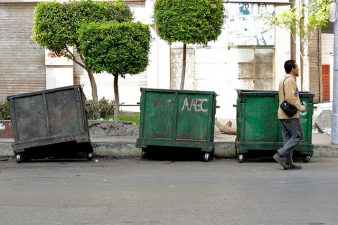Last years e-waste weighed substantially more than all the adults in Europe, or as much as 350 cruise ships the size of the Queen Mary 2. Another metric: 15 pounds for ever person on earth, every year.
Wonder why the planet is lashing back with plagues like Covid-19, floods, global warming? It’s all connected and even though over there and out there is far away, a record amount of e-waste or electronic waste is building up in our planet putting everyone, not just the vulnerable –- at risk.
The United Nations sent Green Prophet a new report: a record 53.6 million metric tonnes (Mt) of electronic waste was generated worldwide in 2019, up 21 per cent in just five years, according to the United Nations in their Global E-waste Monitor 2020.
The new report also predicts global e-waste – discarded products with a battery or plug – will reach 74 Mt by 2030, almost a doubling of e-waste in just 16 years. This makes e-waste the world’s fastest-growing domestic waste stream, fueled mainly by higher consumption rates of electric and electronic equipment, short life cycles, and few options for repair.
A sad state for electronics recycling
Only 17.4 percent of 2019’s e-waste was collected and recycled. This means that gold, silver, copper, platinum and other high-value, recoverable materials conservatively valued at US $57 billion — a sum greater than the gross domestic product of most countries – were mostly dumped or burned rather than being collected for treatment and reuse.
Who are the biggest polluters, by continent?
Asia, no doubt, being the factory and dumpsite of the world, generated the greatest volume of e-waste in 2019 — some 24.9 Mt, followed by the Americas (13.1 Mt) and Europe (12 Mt), while Africa and Oceania generated 2.9 Mt and 0.7 Mt respectively.
E-waste is a health and environmental hazard, containing toxic additives or hazardous substances such as mercury, which damages the human brain and its coordination system.
About 15 pounds for ever person on earth
- Proper e-waste management can help mitigate global warming. Countries like Israel have made plans and bills but there is very little on the ground enforcement. It’s especially a concern in places like China where the oversight in production is murky and where it is hard to find details of true environment conservation. In 2019, an estimated 98 Mt of CO2-equivalents were released into the atmosphere from discarded fridges and air-conditioners, contributing roughly 0.3 percent of global greenhouse gas emissions. That means every new appliance you buy, one goes to landfill.
- In per capita terms, last year’s discarded e-waste averaged 7.3 kg for every man, woman and child on Earth.
- An estimated 50 tonnes of mercury — used in monitors, PCBs and fluorescent and energy-saving light sources — are contained in undocumented flows of e-waste annually.
- E-waste in 2019 was mainly comprised of small equipment (17.4 Mt), large equipment (13.1 Mt), and temperature exchange equipment (10.8 Mt). Screens and monitors, small IT and telecommunication equipment, and lamps represented 6.7 Mt, 4.7 Mt, and 0.9 Mt respectively.
- Since 2014, the e-waste categories increasing fastest in total weight terms are: temperature exchange equipment (+7 percent), large equipment (+5 percent), lamps and small equipment (+4 percent). According to the report, this trend is driven by the growing consumption of those products in lower-income countries, where those products improve the living standards. Small IT and telecommunication equipment have been growing more slowly, and screens and monitors have shown a slight decrease (-1 per cent), explained largely by lighter flat panel displays replacing heavy cathode ray tube (CRT) monitors and screens.
- Since 2014, the number of countries that have adopted a national e-waste policy, legislation or regulation has increased from 61 to 78. While a positive trend, this is far from the target set by the International Telecommunication Union (ITU) which is to raise the percentage of countries with an e-waste legislation to 50 per cent.



